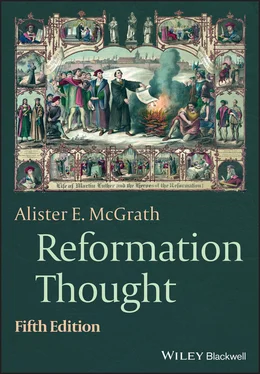Yet Luther wanted to reach beyond an academic readership, and touch the hearts and minds of ordinary people. The decision to publish in German was iconic, making a statement about the inclusive nature of the reformation that Luther proposed to pursue. To publish in Latin was to exclude the ordinary people. To publish in his native German was to democratize the debate about the future of the church, by including those who were traditionally marginalized by the use of the ancient scholarly language. From that moment onward, one of the hallmarks of Protestantism would be its use of the vernacular at every level. The Latin liturgy of church services would be replaced with vernacular alternatives. Most importantly of all, the Bible would also be translated into the language of the people.
An example will help illustrate the importance of both printing and the use of the vernacular to the propagation of the ideas of the Reformation. A crucial turning point in the French Reformation was marked by the publication of the French-language edition of Calvin’s Institutes of the Christian Religion in 1541. The work had originally been published in Latin in 1536. Calvin, who was French, realized the importance of explaining his ideas in everyday language. Suddenly, coherently expressed and carefully justified radical reforming doctrines were available within France in a language which most could understand (see pp. 274–6).
This development caused near panic in Paris. On July 1, 1542, the Parisian authorities directed that all works containing heterodox doctrines, especially Calvin’s Institutes , were to be surrendered to the authorities within three days. Calvin’s Institutes were seen as the spearhead of a Genevan assault upon the French Catholic church, mediated through the printed word in French. The reaction from the booksellers of Paris was immediate: they protested that they would face financial ruin if they were prohibited from selling such books. There was a popular demand for works which were considered to be dangerously unsound by the authorities – further evidence of the importance of a literate and affluent laity in promoting the ideas of the Reformation. Indeed, the bookseller Laurent de Normandie, a friend of Calvin, found the contraband book trade so profitable that he emigrated to Geneva, in order that he could publish such books rather than just sell them.
This naturally leads us to consider the importance of the new cultural environment which arose through the use of movable type in printing, widely regarded as transforming western European culture.
The Importance of Printing
Recent technological developments in the field of data processing and transfer – such as the Internet – have revolutionized many aspects of modern life. It is important to realize that a single technological innovation destined to have an enormous influence over western Europe was developed on the eve of the Reformation. This innovation was, of course, printing. It would have a very substantial impact on the development and propagation of the ideas of the Reformation.
Although originally developed centuries earlier by the Chinese using wooden printing blocks, the development of moveable (and reusable) metal type is associated with the German printer Johann Gutenberg (c.1398–1468) at Mainz around 1454. In 1456, Gutenberg produced the first printed Latin Bible, now generally known as the “Gutenberg Bible.” This was followed in 1457 by the so-called Mainz Psalter, which established the custom of identifying the printer, the location of the press, and the date of publication on the title-page of the work. From Germany, the technology was taken to Italy, presses being established at Subiaco (1464) and Venice (1469). William Caxton set up his printing shop at Westminster, London, in 1476. The famous Aldine Press was established at Venice in 1495 by Aldus Manutius Romanus. This press was responsible for two important developments: “lower case” letters (so-called because they were kept in the lower of two cases containing the metal type) and the sloping “italic” type (so-called in English-language works, on account of Venice being located in Italy; Aldus himself called the type “Chancery”).
Why would printing have such a major impact upon the Reformation? The arrival of printing meant that works advocating the agendas and leading ideas of the Reformation could be produced quickly and cheaply, and transported over international frontiers, legally or illegally. It was easy for smugglers to conceal books or printed pages, making it difficult to prevent the free international movement of ideas. As a result of this development, anyone who could read and afford to purchase books was able to encounter the sensational new ideas coming out of Wittenberg in the 1520s and Geneva in the 1550s.
For example, in England it was the literate and financially advantaged classes who knew most about Lutheranism in the third decade of the sixteenth century. Lutheran books, banned by the authorities as seditious, were smuggled in through the Hanseatic trade route to Cambridge via the ports of Antwerp and Ipswich. The greater influence of Luther at the University of Cambridge than at Oxford partly reflects the former’s proximity to the continental ports from which Protestant books were being (illicitly) imported. There was no need for Luther to visit England to gain a hearing for his ideas – they could be spread by the printed word (see pp. 266–7). This point is of interest in relation to the sociology of early Protestantism. In both England and France, for example, the first Protestants were often drawn from the upper strata of society, precisely because these strata possessed the ability to read and the money to pay for books (which, as they often had to be smuggled in from abroad, were generally rather expensive).
It is important to note that the Reformation was based upon certain specific sources: primarily the Bible, and secondarily the Christian theologians of the first five centuries (often referred to as “patristic writers”), particularly Augustine of Hippo. The invention of printing had two immediate consequences for these sources, of considerable importance to the origins of the Reformation. First, it was possible to produce more accurate editions of these works – for example, through the elimination of copying errors. By comparing the printed text of a work with manuscript sources, the best possible text could be established and used as the basis of theological reflection. In the late fifteenth and early sixteenth centuries, humanist scholars rummaged through the libraries of Europe in search of patristic manuscripts which they could edit and publish.
As a result, these sources were made much more widely available than had ever been possible before. By the 1520s, just about anyone could gain access to a reliable edition of the Greek text of the New Testament or the writings of Augustine of Hippo (354–430), a patristic writer particularly favored by both Protestant and Catholic theologians of this age. The eleven volumes of the collected works of Augustine were published at Basle by the Amerbach brothers, after an editorial process lasting from 1490 to 1506. Although only 200 copies of each volume seem to have been published, they were widely used to gain access to the most reliable text of this important writer.
Erasmus of Rotterdam produced the first published text of the Greek New Testament in 1516. (A rival scholarly edition, developed by scholars at the Spanish university of Alcalá, was ready to print by this time, but was not actually published until 1522.) Entitled Novum Instrumentum omne , Erasmus’ work had three main sections: the original Greek text of the New Testament; a new Latin translation of this Greek text, which corrected inadequate existing translations, especially the Vulgate (see pp. 119–20); and finally, an extended commentary on the text, in the form of annotations. Despite some problems, Erasmus’ Greek text was widely respected, and came to be known as “the received text (Latin: textus receptus ).”
Читать дальше

![О Генри - Возрождение Каллиопы [The Reformation of Calliope]](/books/407342/o-genri-vozrozhdenie-kalliopy-the-reformation-of-c-thumb.webp)









